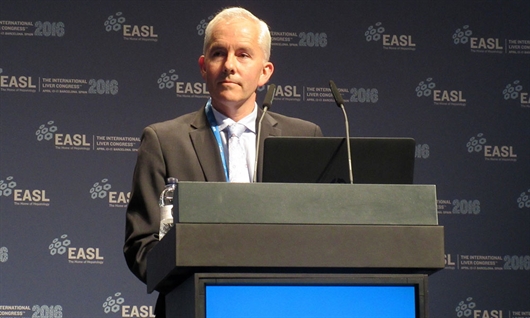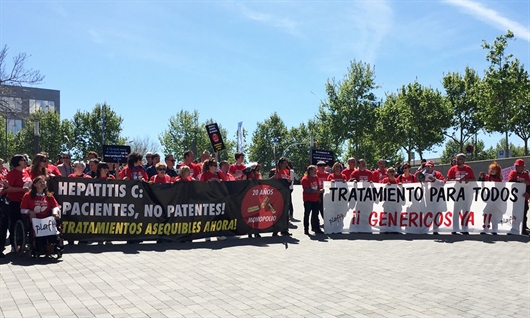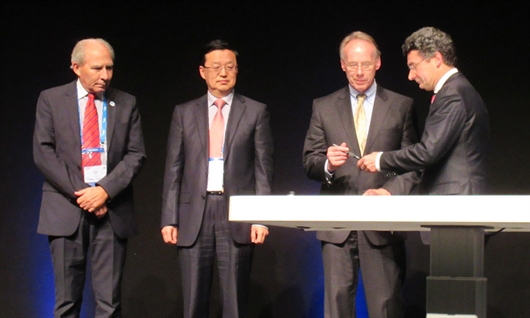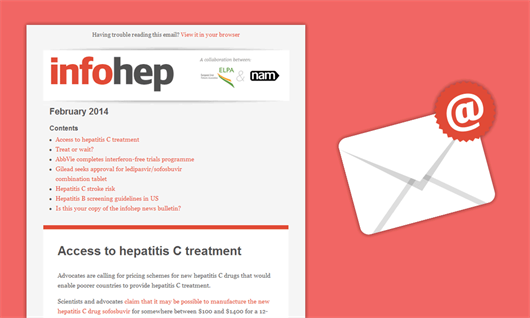
Dr James Freeman presenting at ILC 2016. Photo by Liz Highleyman, hivandhepatitis.com
Generic versions of direct-acting antivirals (DAAs)
purchased from China and India by people unable to obtain treatment in their
own countries were just as effective and safe as the branded products, a study
of 139 patients monitored by Australian doctor James Freeman has shown. The
findings were presented in a late-breaking research session at the International Liver
Congress in Barcelona earlier this month.
The high cost of branded DAAs has led to rationing of treatment, slow drug approvals
and refusal of insurance coverage in many countries. People unable to obtain
hepatitis C treatment through existing health care have turned in desperation
to the FixHepC buyer’s club for help in obtaining generic
versions of sofosbuvir, sofosbuvir/ledipasvir and daclatasvir.
Importation of medicines for
personal use is permitted under customs regulations in Australia and the United
Kingdom, and many other countries have regulations permitting the importation
of small amounts of medicines for personal use or their carriage through
customs in personal luggage. The FixHepC buyer’s club provided advice and
information on how to do this safely and legally, starting in Australia, but
soon responding to enquiries from people in Europe, North America, New Zealand
and South East Asia.
FixHepC recommends that people
who use its buyer’s club to obtain generic versions of hepatitis C drugs order
products from companies in India, which have undergone manufacturing inspection
by the World Health Organization (WHO) and that have a track record of
manufacturing high-quality antiretroviral drugs for HIV treatment in large
volumes. FixHepC is able to provide information about which companies have this
experience. Nevertheless, it is important to note that, to date, no companies
manufacturing DAAs have applied for or received WHO
prequalification for hepatitis C products. WHO prequalification is the gold
standard for generic products, and WHO has called on manufacturers to submit
hepatitis C products for prequalification in order to build confidence in the
quality of generic DAAs.
The FixHepC project used a test
employed in pharmaceutical manufacturing to test medication ordered by people
who used its service, in order to check that products contained the stated
quantity of active ingredient.
Interim results from the study
(four weeks after the completion of treatment) show that overall, 94.4% of
people who received generic versions of DAAs had a
sustained virologic response at this time point, similar to the performance of
branded versions in large real-world cohorts (see below for more details).
The findings received prolonged applause from the large
audience of liver specialists. Many leading liver specialists expressed
frustration during the conference at the high prices of DAAs and the rationing of these drugs on the grounds of cost by governments
and insurers.
But the study presented by Dr Freeman represents the tip of
the iceberg in terms of the impact of generic drugs on hepatitis C treatment.
Although obtaining generic drugs may help many individuals currently denied
treatment on the grounds of cost, mail-order treatment is not a sustainable
solution to a major public health problem. Only a combination of affordable
pricing by companies and a commitment to hepatitis C treatment by governments
will make a hepatitis C cure widely accessible.

Activists demanding access to hepatitis C treatment at ILC 2016. Photo by Liz Highleyman, hivandhepatitis.com
For lower-income and lower middle-income countries, generic
versions of DAAs offer the prospect of affordable treatment
– if governments and manufacturers can navigate a maze of voluntary licensing
restrictions and exploit flexibilities in the TRIPS trade agreement which
permit use of generics in some circumstances even when drugs are patented.
Several
sessions at the conference highlighted the progress already being made in some
countries as a result of the availability of generic DAAs.
Manufacturers in India are able to make a course of DAA treatment for less than
$300. As the volume of orders and the number of tenders increases, prices are
likely to fall further as a result of competition. Uptake of hepatitis C is
growing in India and Pakistan. In Egypt the government aims to treat 400,000
people by 2017, largely through the use of generic products. However, for Egypt
to achieve the goal of elimination of hepatitis C – a 95% reduction in new
infections – a large increase in screening for hepatitis C and in diagnosis and
referral will be needed.
Activists at the Barcelona meeting called for access to generic DAAs, not just in lower- and middle-income countries, but in higher-income countries too. They called for an end to the rationing of treatment on the grounds of cost, pointing out that Gilead has already earnt more than $32 billion from hepatitis C drugs. Whereas Gilead charges up to $84,000 for a course of Sovaldi (sofosbuvir) in the United States, generic versions can be produced in India for less than $300 for a course of treatment.












Connect with infohep on Facebook: Keep up to date with all the latest news and developments.
Follow infohep on Twitter for links to news stories and updates from infohep.org. Follow us at www.twitter.com/infohep.
Follow all the infohep news by subscribing to our RSS feeds.